| Columns Retired Columns & Blogs |
The Sonus Faber Lumina III is NOT a standmount speaker, it's a floorstander
I used DRA Labs' MLSSA system, an Earthworks microphone preamplifier, and a calibrated DPA 4006 microphone to measure the Fyne Audio F500SP's farfield behavior, and an Earthworks QTC-40 mike for its nearfield responses. I left off the grille for the measurements. I used Dayton Audio's DATS V2 system to measure the impedance magnitude and electrical phase angle.
Fyne Audio specifies the F500SP's sensitivity as a high 90dB/2.83/m. My estimate was 87dB(B)/2.83V/m. The F500SP's impedance is specified as 8 ohms; I found that the impedance magnitude (fig.1, solid trace) remained above 6 ohms for almost all the audioband, with a minimum value of 5 ohms between 157Hz and 203Hz. The electrical phase angle (dashed trace) is occasionally high, and the EPDR (footnote 1) drops to 3 ohms between 111Hz and 161Hz, with a minimum value of 2.32 ohms at 121Hz. The F500SP's EPDR lies above 4 ohms throughout the treble, however, and overall, this loudspeaker will be relatively easy to drive.
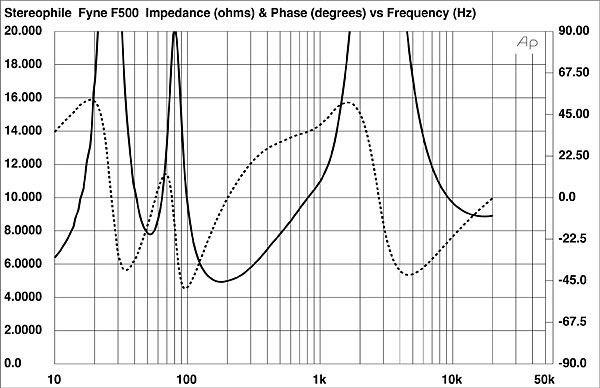
The traces in fig.1 are free from the small discontinuities that would imply the presence of resonances of some kind. When I investigated the enclosure's vibrational behavior with a plastic-tape accelerometer, I found a couple of resonant modes on the side panels (fig.2). However, these are relatively low in level, have a moderately high Q (Quality Factor), and are relatively high in frequency, all of which will work against audibility.
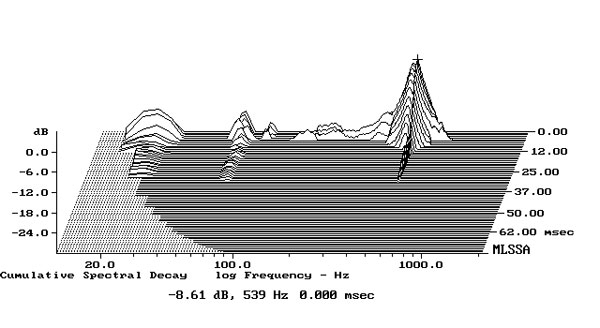
The saddle centered on 53Hz in the impedance-magnitude trace suggests that this is the tuning frequency of the downward-firing port that reflex-loads the woofer. The red trace in fig.3 shows the port's nearfield output measured at the opening at the speaker's base. The response broadly peaks slightly higher in frequency than the port tuning frequency, and the upper-frequency rolloff is clean, though a low-level peak can be seen between 600Hz and 700Hz. The blue trace below 350Hz shows the nearfield response of the woofer.
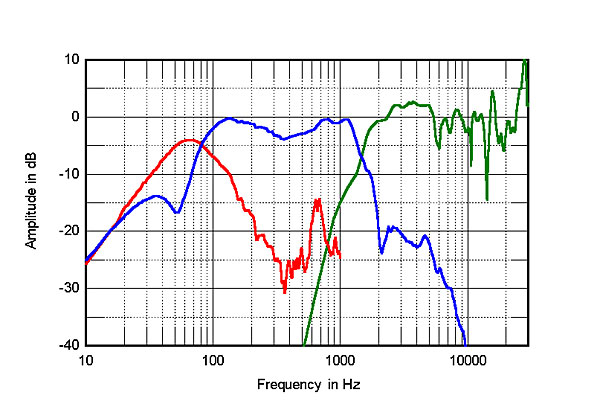
The woofer's farfield output peaks slightly before crossing over to the tweeter (fig.3, green trace) at 1.5kHz. The tweeter's fundamental dome response lies well above the audioband, at 29kHz, but the drive unit's output above 5kHz is disturbed by narrow peaks and dips. I suspect that this behavior is due to reflections of the coaxially mounted, horn-loaded tweeter from the circumference of the woofer cone. The tweeter appears to be balanced a couple of dB higher in level than the woofer, which, in combination with the latter's slightly shelved-down output in the midrange, could make the F500SP sound a little thin.
Fig.4 shows the F500SP's farfield response averaged across a 30° horizontal window centered on the tweeter axis. The boost in the upper bass is due to the nearfield measurement technique, and the response has a slightly rising trend from the middle of the midrange through to the mid-treble.
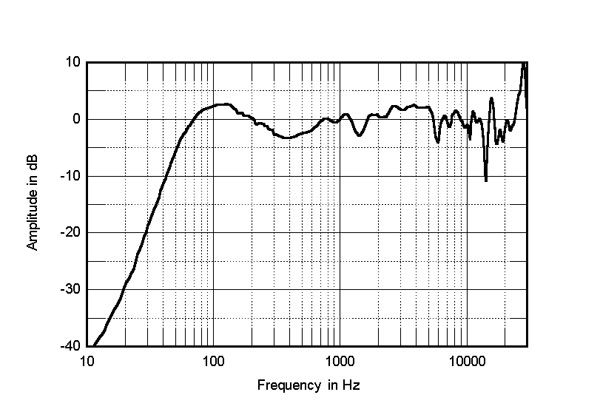
The Fyne's horizontal dispersion is shown in fig.5. (The traces are normalized to the response on the tweeter axis, which thus appears as a straight line.) The loudspeaker becomes more directional as the frequency increases above the midrange, which will tend to compensate for the tweeter's +2dB balance, but the off-axis behavior is complex in the region where the on-axis response has narrow peaks and dips. Experimenting with toe-in may well optimize the F500SP's top-octave balance. The Fyne Audio's vertical dispersion, again normalized to the response on the tweeter axis, is shown in fig.6. As expected from the symmetrical drive-unit array, it is similar to the speaker's behavior in the horizontal plane.
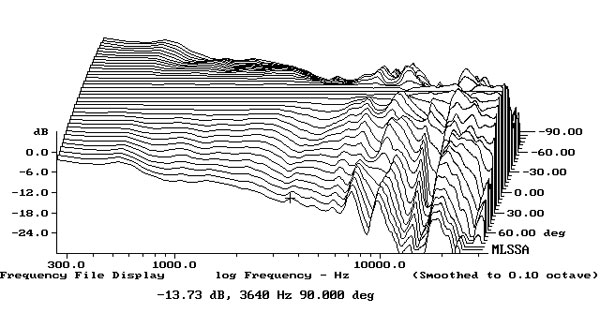
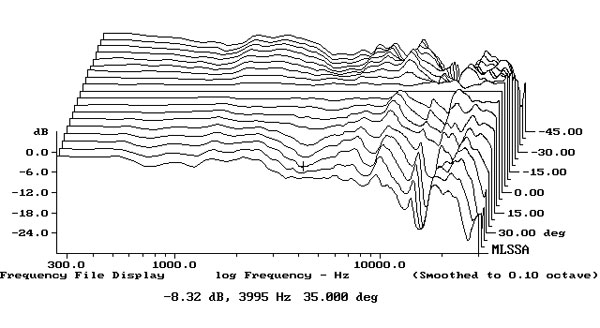
Turning to the time domain, the F500SP's step response on the tweeter axis (fig.7) indicates that the woofer's output arrives first at the microphone and that this drive unit is connected in positive acoustic polarity. The tweeter is connected in negative polarity and, as expected from its coaxial mounting at the rear of the woofer's pole piece, its output arrives after the woofer's. The F500SP's cumulative spectral-decay plot (fig.8) is generally clean, though with three narrow-band ridges of resonant decay present in the mid-to-high treble.

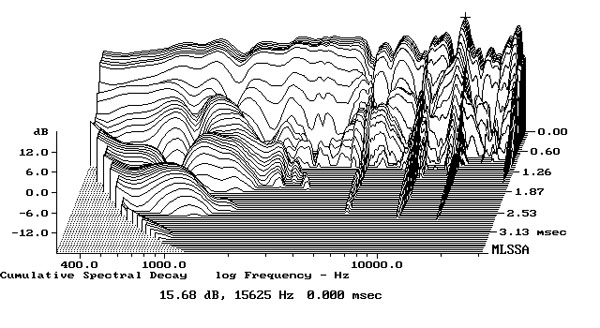
The Fyne Audio F500SP's measured performance is dominated by its use of a coaxially mounted tweeter. Careful experimentation in positioning and toe-in should optimize its balance.—John Atkinson

The Sonus Faber Lumina III is NOT a standmount speaker, it's a floorstander

The Sonus Faber Lumina III is NOT a standmount speaker, it's a floorstander
Fixed. Thanks for spotting the error.
John Atkinson
Technical Editor, Stereophile

Can't really see any reason to pick this over the similarly priced KEF R3. The only advantage I cans ee is tat the impedance/phase load seems a lot easier to handle over the KEF, so amplifiers not up to the task of powering the KEF could give more dynamics with this Fyne.

Hi
Agreed above. This physics.
First glance made me think about the famed historical Tannoy coaxial 'full-range' speaker units. No wonder, both the then Tannoy technical & marketing chiefs quitted to form their own loudspeakers company.
IMO, USD3,000 paired (including the indispensable matched floor stand) is way way too costly vs Tannoy Gold 7 6.5" coaxial driver POWERED (built-in 300W Class AB amp) monitor for only USD369x2 per pair !!!!!!!!
With such huge saving, I would go for Fynes alma mater: Tannoy UK.
With built-in biamp, the Tannoy Golde 7 will surely reproduce bass much much better !
Also, this review did not mention where the Fynes are built (hopefully in Scotland!). Not even shown at the back panel of the loudspeakers !!??
Am I a too smart consumer or a cheapskate or what ??
Jack L

Also, this review did not mention where the Fynes are built (hopefully in Scotland!).
We do say on the Specifications page that the Fyne speakers are "Designed, engineered, and made in UK." Scotland is in the UK (for now, at least).
John Atkinson
Technical Editor, Stereophile

Hi
Thanks for pointing out.
Jack

for the KEF R3 or LS50 Meta. I'd like to see a shootout between those three. Every time I listen to the Metas I wish I could afford them!

Unlike a 15 inch dual concentric Tannoy speaker measured by Stereophile may years ago, this Fine dual concentric has quite good high frequency dispersion. More high end dispersion than some dome tweeters such as those in Spendor.